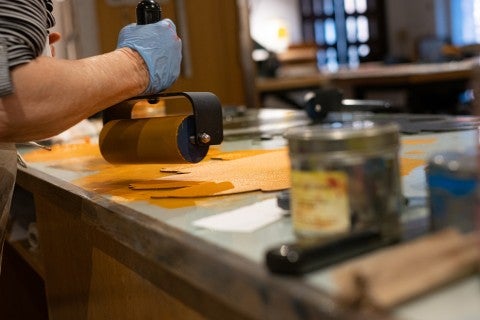Degree(s): BA, Rice University, 1980
VADA Concentration: Film
Rice Graduation Year: 1980
Mark Brice, who graduated from Rice in 1980, was awarded an Emmy for cinematography for the Carrier series produced by Mel Gibson. Mark was one of Professor Brian Huberman's first students at Rice and has worked on many documentary productions including National Geographic's Doctors Without Borders and Paramedics. Brice said, "The Emmy is for Outstanding Cinematography for a Reality Series, for the Carrier series, which was shown on PBS. Carrier is a 10-hour series following a six-month deployment of the U.S.S. Nimitz aircraft carrier group in the Persian Gulf. The Award was given at the Creative Arts Emmys at the Nokia Theatre in Los Angeles on Saturday, September 13. [Mark Brice] gave the acceptance speech! The show will be broadcast on the E! Entertainment Network on Saturday, September 20." When James Blue, the then-director of Rice Media Center, walked into a Texas classroom some 30 years ago, a self-described regular kid took his first step toward an extraordinary career that has taken him around the world, quite literally. Mark Brice ‘80 has spent time sleeping under the stars in Africa, crossing through war zones in Burundi, trailing an anti-kidnapping unit in Brazil, and living aboard an aircraft carrier in the Persian Gulf. It’s that last experience that led Brice, a documentary filmmaker, to the strangest place of all: Hollywood. Brice was awarded the Emmy for Outstanding Cinematography for a Reality Series for his work on the PBS film “Carrier.” Produced by Mel Gibson, “Carrier” is a 10-hour series that follows a six-month deployment of the USS Nimitz aircraft carrier during the Iraq War. “The Media Center at Rice was my launching pad,” Brice said. “When James Blue came into my high school and showed us a 16-millimeter film he shot in Africa and talked about what he did, I thought, ‘I want to do that.’” Though Brice discovered his passion that day, he couldn’t convince himself to pursue it fully. A wannabe marine biologist, he came to Rice as a biology major, th inking he would only dable in film in his spare time. “I took film classes as electives,” Brice said. “It seemed like a nice break from the academic pressures of Rice. But then I realized it was because my heart wasn’t in the hard sciences.” Spending hours and hours synching audio and video wasn’t without pressure, but Brice loved it. He still laughs fondly when he talks about the late nights he spent at the Media Center fine-tuning picture and sound while hearing Orson Welles’ “Touch of Evil” play in the screening room. “I remember Mark as a student very well,” said Brian Huberman, chair of Visual and Dramatic Arts. “I would see him late at night in the editing room focused on his work. It was clear early on that he was committed to filmmaking.” The commitment sometimes took extreme forms. In making a film about racial violence spurred by an incident on the Texas coast, Brice ended up with Huberman and a cameraman driving around back roads at night, unarmed, to film a Ku Klux Klan induction rally. Upon arriving, they were immediately surrounded by men with rifles. It’s one of the most memorable experiences Huberman has had as a teacher. “I had a really good chance to see him in action,” Huberman said with a laugh. As for the physical strains throughout his career. Brice explains that the documentary medium rarely allows for posh conditions. “The challenge of making a documentary is always finding a way to do your best work and be open to discovery when you are uncomfortable, when you’re not eating right, when it’s 110 degrees and you have no shade in sight, when the weather is fogging up your goggles on an aircraft carrier and you have no way of knowing exactly what kind of picture you’re shooting.” But Brice doesn’t complain. Instead he talks about the awe he’s felt and the privileges he has had. “If you really like what you’re doing, those trying conditions are all worth it. Anything for the chance for the best pictures ever,” Brice said. “You try to capture things that no one has ever seen before. I’ve had the chance to see the Pacific Ocean where it’s seven miles deep – it’s a color blue you can’t describe.”


